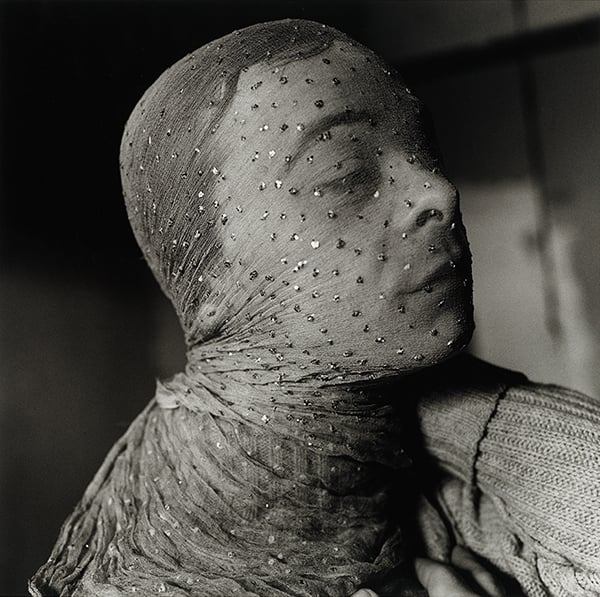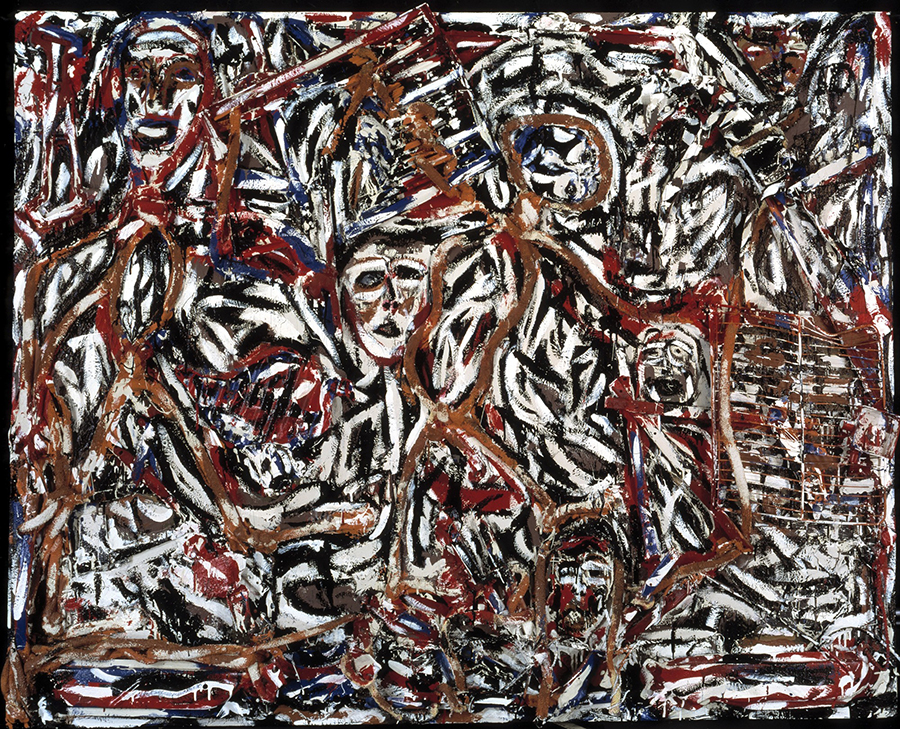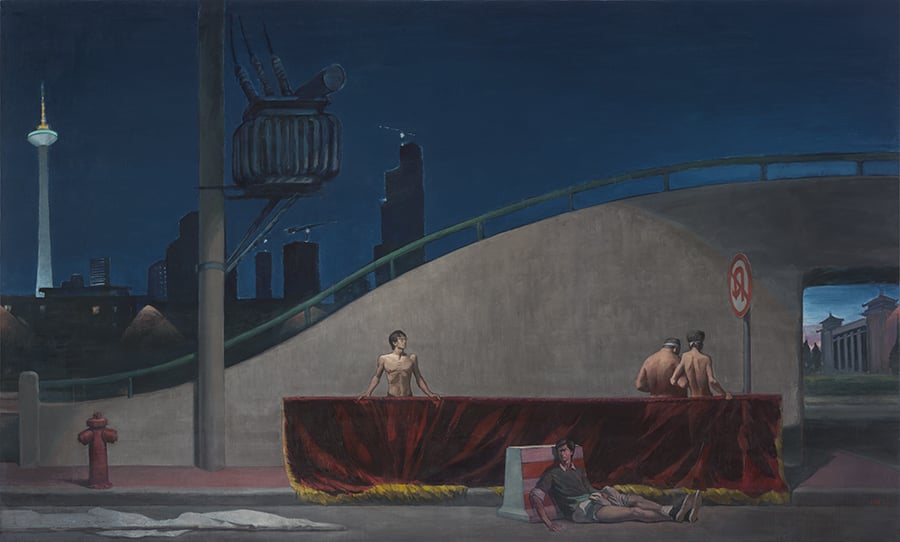
“Gary Indiana Veiled,” 1981, by Peter Hujar © 2022 The Peter Hujar Archive/Artists Rights Society, New York City
Few writers are as keenly alive to absurdity or write with as sharp a pen as Gary Indiana, whose new essay collection, Fire Season (Seven Stories Press, $23.95), spans almost forty years of stellar criticism. Born Gary Hoisington in 1950, Indiana, also a playwright and novelist, was the regular art critic for the Village Voice in the mid-Eighties and has continued since to write incisively about artists and the art world. The collection gathers pieces about Barbara Kruger, Tracey Emin, Roni Horn, and Sam McKinniss, among others, as well as a beautiful tribute to Louise Bourgeois, who was a friend of Indiana’s. But his interests are expansive, and he also pays significant attention to film and filmmakers, from Jean-Pierre Melville, Robert Bresson, and Pier Paolo Pasolini to Daniel Schmid and Barbet Schroeder. Indiana’s literary attention is devoted to writers similarly at an angle to the mainstream, including Samuel Beckett, Unica Zürn, Pierre Guyotat, Jean-Patrick Manchette, and Jean Echenoz. As Christian Lorentzen observes in his perspicacious introduction, “Indiana’s subjects, yoked together, take on the quality of a personal canon.”
When I was at university in the mid-Eighties and setting out in the world soon thereafter, Indiana’s sensibility, and indeed his canon, were formative for my cohort, and it’s enormously pleasurable to revisit his brilliant mind. This was an era in which artistic complexity and even obscurity were prized, along with challenging French theory. (“You don’t have to read Lacan to appreciate this work,” he writes of Kruger, “but Lacan is helpful if you want to take the work in without miring yourself in direct, frontal relation to what it’s saying at the moment you’re looking at it.”) In fact, Frenchness was a recurring feature not only of the theorists, but of the artists, writers, and filmmakers as well.
Perhaps the central feature of Indiana’s writing remains its elegant and astringent wit. At times, this can look like nastiness; but just as the difference between the erotic and the pornographic is said to be that the latter is gratuitous, so too is strong critique distinct from simple nastiness in being purposeful. It is difficult to resist, for example, Indiana’s gripe about the second volume of Beckett’s collected correspondence, which he refers to as
an endless Chinese banquet at which all but the most determined gourmands are likely to feel stuffed somewhere between the crispy pig ears and the thousand-year eggs: some may thrill to the hairpin turns and daredevil high jinks involved in the translation of Molloy from French into English, but many with more than a glancing interest in Beckett may find by page 200 or so that his correspondence and its staggeringly detailed footnotes have, to torture a phrase from Jane Austen, delighted them quite enough for one evening, and will put this tubby, ill-proportioned book aside until that fortuitous and chimerical month in the country they’ve set aside to read Proust in his entirety.
Indiana also turns his stinging clarity on living subjects, reporting on topics as diverse as the 1992 New Hampshire primaries (“up close, Bill Clinton looks like he’s covered in fresh fetal tissue”), the Rodney King trial (“LA feels as if it’s wobbling between halting efforts at multicultural accommodation and Bosnia-Herzegovina”), and Disneyland Paris (“a very dim suburban notion of luxury”). He also offers insights that could be called wisdom, noting, for example, that
most of what’s been written about my own work, including by me, has always seemed alien to what I had in mind. How something is made, and why something is made, are matters that often get lost in the public reception of that thing. Quite often artists forget why they made something: it just seemed like the thing to do at the time.
Some pieces may read differently now than when they were first published, as the urgency of the avant-garde has been subsumed by the inescapability of mass media. And it’s true that Indiana’s work can feel not wholly contemporary, insofar as it refuses ever to be nice. This, thank goodness, ensures its timelessness.

Top of the Line (Steel), 1992, by Thornton Dial Sr. © 2022 Estate of Thornton Dial/Artists Rights Society, New York City. Courtesy the Smithsonian American Art Museum, gift from the collection of Ron and June Shelp
In fiction, we find a different timelessness: each work teaches us how to read it, engaging more or less with formal or genre conventions, and thereby shaping our understanding. With her new book, Scary Monsters (Catapult, $16.95), Michelle de Kretser asks us to shift from the familiar. The volume comprises what this reader would consider two first-person novellas, presented Janus-faced. Each side of the book offers a front cover, and you can flip the volume to determine which voice you’ll encounter first: that of Lili, set in Montpellier, France, in the Eighties, or Lyle, set on the outskirts of Melbourne, Australia, in the near future.
This graphic split has been deployed before, for example in an edition of Carol Shields’s Happenstance, or, more recently, with Aleksandar Hemon’s My Parents: An Introduction/This Does Not Belong to You. In the former, the two protagonists are spouses; in the latter, Hemon offers parallel memoirs of his parents’ lives and his own. In Scary Monsters, however, the two protagonists have similar names, but their stories unfold on different continents in different centuries, linked thematically.
Whether you begin with Lili or Lyle, the range and verbal pleasures of de Kretser’s considerable gifts are compelling. Both sections explore themes of gender, race, and displacement: the book’s title quotes a David Bowie song (“Scary monsters, super creeps / Keep me running, running scared”) that also evokes, for Lili, Bowie’s protofascist Thin White Duke persona of the mid-Seventies. But the relationship between Lili and Lyle—both of whom are emigrants in jeopardy from the hegemonic culture, albeit in different ways—is intuitive, rather than overtly drawn.
Lili recounts a year spent teaching in Montpellier at age twenty-two, before going on to do graduate work at Oxford. She grew up in Australia, having emigrated from Asia as a teenager; her mother is of Armenian extraction. De Kretser captures with luminous specificity Lili’s experiences as a young woman in provincial France in the early Eighties—specifically a young, non-French, anglophone woman of color. Lili learns, avidly, about the experiences of the Algerians around her; her undergraduate studies had misleadingly taught her that “everything we needed to know about Algeria could be found in Camus.” Her glamorous new bestie Minna, the girlfriend of her colleague Nick, seems to know much that Lili doesn’t, and charms Lili with her careless bohemianism. She’s also wealthy, bolstered not only by money but by Nick, while Lili, living alone with a creepy, intrusive older neighbor named Rinaldi, struggles with constant anxiety:
My jaw often ached that winter—after a while I realized that I was clenching my teeth from fear. Why didn’t I buy a torch to light me down from the WC? . . . But I reasoned that my fear had no grounds so the expense was unnecessary. What I find remarkable now is that I valued my life at something less than a few francs.
Lili’s year in Montpellier follows the arc of her friendship with Minna and Nick, culminating in a trip the women take to Sardinia to meet with John Berger’s mistress (apparently a friend of Minna’s mother). Over time Lili gradually awakens to the complexities of race and class, and in these moments of heightened awareness de Krester’s biting sense of humor is often on full display. In one scene in Genoa, the friends struggle to find a decent place for lunch. Minna, something of a champagne socialist, judges the nearby establishments too bourgeois. As the two haul their packs around in search of an authentic worker’s restaurant—a ristorante popolare—Lili privately despairs:
It seemed to me that what she was looking for was men in collarless shirts and blondes with heavy, pearly arms—the object of her search wasn’t a restaurant but an Impressionist painting.
When they finally find a place, at the direction of a sufficiently popolare passerby—“ ‘Did you see the way he held the pen?’ Minna asked, delighted, as we walked away. ‘Like a chisel’ ”—the sight of benches full of sweaty workers, one of whom upends a raw egg over his pasta, proves a bit too rustic, prompting Minna to beat a hasty retreat to the “first petit bourgeois place that we saw.”
At the conclusion of Lili’s story, France awakens to socialism and elects its first left-wing government in years—a note of hope. Yet half a century later, Lyle, in his grueling suburban life outside Melbourne, is in a considerably more troubling situation, preoccupied by dilemmas that arise from his family’s social position. Islam has been outlawed, and the bleak effects of climate change are inescapable. As Asian immigrants to Australia, Lyle and his wife, Chanel, make every effort to succeed, with mercenary goodwill: “People like us will never be invisible, so we have to make a stupendous effort to fit in.” They’ve changed their names, for starters, and have turned away from the past: “The whole point of Australia is a bet on the future.” Chanel, keen to impress her boss and move to a better neighborhood, decides that this must involve sacrificing Lyle’s mother, Ivy, who has lived with them and helped to raise their kids. Lyle, meanwhile, works for a sinister government agency known as the Department, where he writes evaluations identifying other migrants for arrest and deportation. What unfolds, rife with dark irony worthy of George Saunders, is as banal as it is horrific. De Kretser is a wonderful writer, and woefully underrated in this country. Though her skewering satire is pointed and painful, her gallows humor keeps the reader smiling.

Shenyang Night, by Wang Xingwei © The artist. Courtesy Galerie Urs Meile, Beijing/Lucerne, Switzerland
Shuang Xuetao is similarly an unfamiliar name to many American readers, even as he is widely celebrated in his native China. Rouge Street (Metropolitan, $26.99), a collection of three novellas lucidly translated by Jeremy Tiang, affords an indelible introduction to Shuang’s work, which has been variously compared to that of Hemingway and Murakami.
Set in the northern industrial city of Shenyang—the city of Shuang’s birth—and specifically in the neighborhood of Yanfen Street (translated as “Rouge Street”), these three narratives depict lives of unremitting struggle and uncertainty. As the novelist Madeleine Thien writes in her thoughtful foreword, the city, once a seat of state-subsidized heavy industry under Mao, was settled by “people thrown unceremoniously together—alleged class enemies and their equally despised children, former felons, hooligans, peasants, migrant workers, and the poor.” By 1998, following China’s market reforms, a million workers were laid off, losing their health care and pensions as companies sought profitability. Shuang’s stories, by turns realist, noirish, and fantastical, unfold in this milieu.
“Bright Hall” is narrated by Zhang Mo, who is sent across town to find his aunt after his father, a single parent, takes a job in another city for the winter. After walking the daunting length of Yanfen Street with a map and provisions, Zhang Mo arrives at Bright Hall, where his aunt is directing a play. We learn that she and her daughter, Gooseberry, returned from performing in America without Gooseberry’s father (“He stayed there to have fun,” Gooseberry explains, in the matter-of-fact way of children). The cousins bond, and as an elaborate plot unfolds around them—involving the murder of a popular preacher and the dark history of his criminal life before the ministry—Zhang Mo and Gooseberry embark on an epic return along Yanfen Street in a nighttime blizzard. Like others in Shuang’s book, this piece turns in its later pages from the powerfully realistic to the fantastical and surreal, in an existential theater reminiscent of Pirandello or Sartre. In context, Zhang Mo’s fate stretches credulity, though this is perhaps Shuang’s point: for some of Yanfen Street’s residents, the imaginary is the only way out.
“Moses on the Plain,” the third of the trio, is still more intricately plotted, its narrative spanning many years. At its heart is the unsolved murder of a policeman who had posed as a taxi driver to catch a serial killer. Around what might, in less capable hands, seem like a premise from Law & Order, Shuang weaves with Dostoevskian skill the voices and experiences of the players in this drama. Among them are two childhood playmates from Yanfen Street, Zhuang Shu and Li Fei, whose lives unexpectedly intersect decades later when Zhuang Shu is a detective investigating the cold case. Through various monologues, the novella creates not just a suspenseful thriller, but a textured, rich portrait of a community over time.






























































































